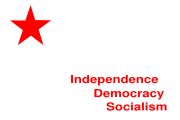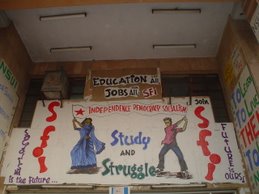On the Struggle against Neoliberalism
Friends,
It is amply clear from the pamphlets issued by the AISA and the ABVP yesterday that they have nothing concrete and substantial to offer, as far as the debate during the JNUSU elections 2007 is concerned, except for a continuous diatribe against the Left. It is indeed strange that AISA and ABVP, supposedly belonging to opposite ends of the ideological spectrum, are speaking in one voice against the Left Front government in West Bengal. However, once one realizes that both the CPI (ML) Liberation and the RSS-BJP are fringe players in the political scene in Bengal and are nothing more than mere appendages to the arch reactionary mahajot against the Left, led by Mamata Banerjee’s Trinamul Congress, the political motivation behind their anti-Left sabre-rattling becomes clear. These cheerleaders of Mamata Banerjee have no other agenda but to malign and weaken the Left Front, which is currently engaged in a crucial battle with the UPA government over the Indo-US nuclear deal and neoliberal economic policies. SFI-AISF appeals to the student community to see through the dubious game of these politically bankrupt organizations who have no constructive agenda to present before the student community and who are hell bent upon converting the students’ union elections in a national university like JNU, into a municipality election in West Bengal.
The juvenile questions raised by the AISA in yesterday’s pamphlet reflect the complete degeneration that has set in the thinking of the ultra-Left in India. The sectarianism inherent within AISA-CPI (ML)’s brand of perpetually confused politics has led them to drag the names of esteemed Marxist intellectuals and pit them against the Chief Minister of West Bengal, in a cavalier and cheap manner. AISA would be foolish to think that the students of JNU, who have a high intellectual and academic level, can be hood winked by such attempts at distorting, trivializing and sensationalizing a serious debate. Following the footsteps of US backed media channels like CNN-IBN, who serves their daily doses of mirch-masaala stories regarding “differences” within the Left to the ultimate satisfaction of the urban elite, the AISA has reduced the level of their pamphleteering to yellow-journalism. They would do well to read the history of the Communist movement in India, which shows that ideological political debates on issues like economic development have been one of the most cherished traditions of the Left. It is precisely because of such a rich and democratic culture of debate and discussion that the Left in India did not meet the fate of the Communist parties in the USSR and Eastern Europe, which had stifled inner-Party democracy to their own detriment. Parties and individuals within the Left do have ideological political differences between them, but that does not deter a broader unity in order to advance the cause of the Left. Unfortunately, sectarian outfits like the CPI (ML) Liberation and AISA, who are neither serious about Left politics nor have any real stake in the Left movement, never realize the importance of either Left unity or intra-Left debate.
The substantive part of AISA’s criticism regarding the Left Front government in West Bengal, is a carbon copy of the bourgeois campaign, that the Left indulges in “doublespeak”, that they implement the same policies in Left ruled states like West Bengal and Kerala which they oppose at the Centre. In this neoliberal era, where the Central Government has withdrawn from the responsibility of undertaking Public Investments through Central Public Sector undertakings and the States have been pushed into a destructive competition of attracting private investments by giving more and more concessions, the Left ruled States are faced with a particularly difficult choice. Either to turn away from private investments altogether (which the ultra-Left wants the Left Front Government to do) or to seek private investment. In the first case, the natural outcome would be industrial stagnation and burgeoning unemployment leading to the unpopularity of the Left Front Governments eventually leading to their downfall. In the second case some degree of industrialization, employment generation and resource mobilization is possible which can provide relief to the people. It is the second path that the Left Front Governments, especially the West Bengal Government, have chosen keeping in mind the fact that the areas in which State Governments continue to have a say, like for instance agriculture or land reforms, alternative policies of the Left would continue to be pursued. It is no wonder therefore, that the most pro-people policies in the sphere of agriculture and land reforms are being implemented by the Left ruled States of West Bengal, Kerala and Tripura. Neither is it surprising that the Left ruled States continue to be the most advanced outposts of working class as well as peasant movements, as can be witnessed by the massive successes of the All India Strikes against neoliberal policies in these States more than anywhere else. Despite their resistance and the best of intentions, the Left ruled States are simply not in a position to change the overall neoliberal direction of economic policies in the country. That can only come about through the ascendancy of anti-neoliberal Governments in more States of the Indian Union and eventually at the Centre. The Left, democratic and progressive forces have to wage much bigger struggles and movements than what has been witnessed till date, in order to bring about such a change in the correlation of political forces in India. Such struggles are being waged under the leadership of the Left across the country and it has gained momentum since 2004, when the Left has been able to project its alternative at a national level in a more effective manner through its interventions at the Centre.
Why should the constraints imposed upon the Left ruled State Governments by the neoliberal regime, however, stop the Left from fighting neoliberal policies at the Centre or the other anti-people State Governments? That is the question we should like to ask all those who charge the Left of indulging in doublespeak, including the AISA. The Left Parties continue to be the only political formation with substantial mass base and Parliamentary strength that consistently opposes neoliberal policies. All the CPI (ML) factions put together do not even have a single representative in Parliament or any State legislature outside Bihar. That is the biggest proof of the fact that the people of India have refused to provide any space in India’s body polity to their petty bourgeois childishness masquerading as ultra-Left politics. AISA seems to have arrived at a conclusion that they only have the right to ask questions to others but not answer any question regarding their own politics and ideology. Never for once do they introspect why the CPI (ML), formed 40 years ago to overthrow the ‘semi-colonial’ Indian state through armed struggle, have ended in a total farce, with the ML itself splintering in innumerable factions engaged in killing each other. They have no answer as to why their ‘armed struggle’ has failed and factions like the ML-Liberation have abandoned that path and joined the parliamentary democratic process, which they once used to term ‘revisionist’. Neither do the AISA ever bother to explain why even after nearly two decades of their participation in the parliamentary democratic process, the CPI (ML) Liberation continues to remain an invisible political force in the country?
The Left Parties can indeed be criticized on many counts. But can anyone question the fact that had it not been for the principled support to a secular Government at the Centre by the Left Parties, the communal forces led by the BJP would have consolidated their rule at the Centre? Who is resisting the strategic alliance between the Indian government and the killer Bush administration, which is sought to be cemented through the nuclear deal? Who has been instrumental in pushing the UPA government to adopt progressive steps like the NREGA, the Tribal Rights Bill, OBC reservations or the Sachar Committee? Who has successfully resisted neoliberal measures like disinvestment, pension privatization, FDI in Retail or Foreign Education Providers Bill? It is because of the fact that the Left Parties have played such a crucial role in resisting anti-people measures and projecting pro-people alternatives at the national level over the past three years that there is such a vicious attack against the Left by the ruling classes and the mainstream media today. The AISA needs to answer what has been the CPI (ML) Liberation’s contribution in this fight against communalism, neoliberal economic policies and imperialism in India over the past few years? Is there any instance of a successful resistance or a progressive alternative to neoliberalism in India, which the AISA or CPI (ML) Liberation can claim as an achievement?
Sd/-Rajiv Kumar Ranjan, Manish Shrivastav, Co-Convenors, CCC, SFI-AISF.





No comments:
Post a Comment